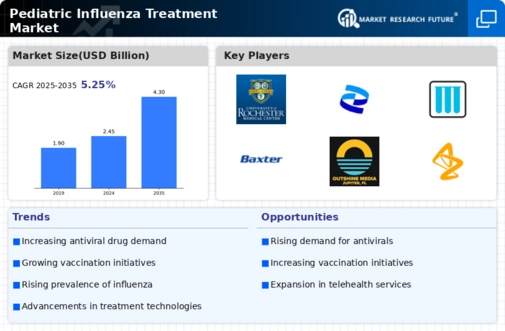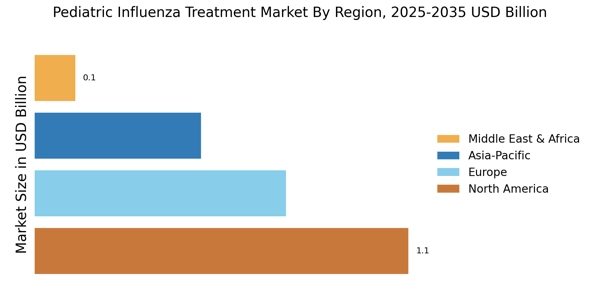Increased Healthcare Expenditure
The Pediatric Influenza Treatment Market is positively impacted by increased healthcare expenditure across various regions. Governments and private sectors are allocating more resources to healthcare, particularly in pediatric care. This trend is evident in the rising budgets for public health initiatives aimed at combating influenza. With healthcare spending projected to grow at a rate of approximately 7% annually, there is a corresponding increase in funding for research and development of pediatric treatments. This financial commitment enables the development of innovative therapies and enhances access to existing treatments for children suffering from influenza. As healthcare systems prioritize pediatric health, the Pediatric Influenza Treatment Market is expected to flourish, driven by improved treatment options and increased accessibility.
Advancements in Antiviral Medications
The Pediatric Influenza Treatment Market is significantly influenced by advancements in antiviral medications. Recent developments have led to the introduction of new antiviral agents that are specifically formulated for pediatric use. These medications are designed to be more effective and have fewer side effects, making them suitable for young patients. The market for antiviral drugs is projected to grow, with estimates suggesting a compound annual growth rate of over 5% in the coming years. This growth is driven by the increasing recognition of the importance of timely treatment in reducing the severity and duration of influenza symptoms in children. As healthcare providers become more aware of these advancements, the adoption of new antiviral therapies is likely to increase, further propelling the Pediatric Influenza Treatment Market.
Growing Awareness of Influenza Vaccination
The Pediatric Influenza Treatment Market is also benefiting from the growing awareness surrounding influenza vaccination. Public health campaigns and educational initiatives have emphasized the importance of vaccinating children against influenza, leading to higher vaccination rates. Data suggests that vaccination can reduce the incidence of influenza by up to 60% in children, thereby decreasing the need for treatment. As more parents recognize the value of preventive measures, the demand for pediatric influenza treatments may shift towards post-exposure prophylaxis and supportive care. This shift indicates a potential change in market dynamics, where the focus may increasingly be on managing influenza cases that do occur, rather than solely on treatment. Consequently, the Pediatric Influenza Treatment Market is likely to adapt to these evolving trends.
Emergence of Telemedicine in Pediatric Care
The Pediatric Influenza Treatment Market is witnessing a transformation due to the emergence of telemedicine in pediatric care. Telehealth services have gained traction, allowing healthcare providers to offer consultations and treatment recommendations remotely. This trend is particularly beneficial for managing influenza cases, as it enables timely intervention without the need for in-person visits. Data indicates that telemedicine usage has surged, with a significant percentage of pediatric patients utilizing these services for influenza-related concerns. This shift not only enhances access to care but also streamlines the treatment process, potentially leading to quicker recovery times. As telemedicine continues to evolve, it is likely to play a crucial role in shaping the Pediatric Influenza Treatment Market, offering new avenues for treatment delivery.
Rising Incidence of Influenza in Pediatric Populations
The Pediatric Influenza Treatment Market is experiencing growth due to the rising incidence of influenza among children. Data indicates that pediatric influenza cases have shown an upward trend, with millions of cases reported annually. This increase necessitates effective treatment options, driving demand for antiviral medications and supportive therapies. As healthcare providers focus on managing influenza outbreaks, the need for innovative treatment solutions becomes paramount. The prevalence of influenza in children, particularly those under five years old, highlights the urgency for effective interventions. Consequently, pharmaceutical companies are investing in research and development to create targeted therapies that cater specifically to this demographic. This trend not only addresses the immediate health concerns but also contributes to the overall expansion of the Pediatric Influenza Treatment Market.


















Leave a Comment